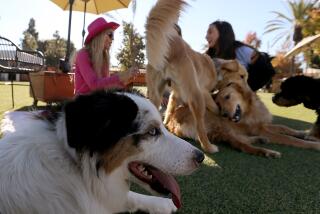Doggone Days of Summer
- Share via
PUTNEY, Vt. — The camp rules are clear: Campers cannot be left loose in the dorm rooms. They must be leashed in public areas, and all poop must be picked up immediately.
This is obviously not your average camp for summer-weary children or budding athletes.
It’s Camp Gone to the Dogs--weeklong sessions of fun, relaxation and recreation for dog enthusiasts and their canine counterparts.
“This is the greatest camp I’ve ever been to,” said Vicki Shaw of Miramar, Fla. as she rubbed her Dalmatian puppy, Nib. “They have top-quality people here. I wish I could squeeze 25 hours into each day.”
Honey Loring, a licensed psychologist, was running a camp for children in the late 1980s when she thought, “I’m a kid, and I want to go to camp. And wouldn’t it be fun if we all could go to camp with our dogs?”
Now in its sixth year of operation, the camp is brimming with participants--some 185 humans and 250 dogs each week and more on a waiting list.
The schedule boasts 35 to 40 activities every day. Among them: tracking and sheepherding lessons; agility and show training; lectures on behavioral and medical problems. There is also an afternoon scheduled with a talent show, tail wagging and kissing contests, and awards for rescued and veteran dogs.
“There’s so much to do,” said Nancy Kembel of Bethlehem, Pa., as she stood in line with her bearded collie, Buffie, for a swim lesson.
“You just don’t want to miss anything.”
The camp is held on the rolling hillsides of The Putney School, a 500-acre private boarding school near Loring’s home.
“I wanted a place where people could spend quality time with their dogs,” she said. “I wanted a camp with good food, no tents and no competition.”
And that is what she has attained.
Lucy, a miniature wire-haired dachshund, ran the lure course--an activity where a dog chases a scarf as it speeds around a field on a guided wire--with as much enthusiasm as Pixel, an Afghan.
Meanwhile, Amy, a small beagle-mix, strained at the end of her leash as she awaited her turn. “She’s normally a couch potato,” said amazed owner Rita Lanson of Hillsboro, N.J. “But she comes to camp and it’s like Jekyll and Hyde.”
Two yellow Labs--Beau from Annapolis, Md., and Emma from Cape Cod, Mass.--wrestled with a stick at the swimming hole, as two other Labs, a Dalmatian and a retriever splashed into the water from the floating dock.
“They met each other last year at camp as pups,” said Andrew Baggs of his dog Beau and wrestling buddy Emma.
“They recognized each other right away and have been playing ever since.”
Claire Rolando of Vernon, Conn., posed her Rottweiler, Goliath, in a cap and vest for a picture to be put on a baseball card.
“When I signed up for this camp,” she said, “my co-workers thought I was crazy.”
“They said, ‘You mean you’re going to camp with your dog and leaving your husband at home?’ And I said, ‘Yes, I am!’ ”
Though initially a bit apprehensive about her first time at camp, Rolando has already signed up herself and her husband for next summer’s session, in lieu of a planned 25th wedding anniversary cruise.
This year’s campers included 91 breeds as well as “designer dogs”--Loring’s term for mixed breeds--from across the United States, Canada, and even the Bahamas.
Most of the dogs at camp are well behaved. Aggressive dogs are not welcome, and more than two dogs per camper is discouraged.
With about half the campers from one year returning the next, Loring does not have trouble filling her camp roster.
Campers pay $650 for a dorm room on campus for themselves and their dog as well as all the activities and lectures. Three full daily meals for owners are included in the fee. Additional housing is available at area inns.
“I don’t want the camp to be any bigger,” Loring said. “What would suffer would be the personal attention I can give my campers, and that’s what I thrive on.”
More to Read
Sign up for The Wild
We’ll help you find the best places to hike, bike and run, as well as the perfect silent spots for meditation and yoga.
You may occasionally receive promotional content from the Los Angeles Times.






